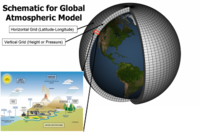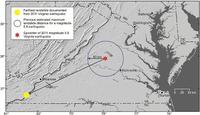-
MIT researchers develop method to help communities plan for climate risk
As the devastation left by Sandy continues to reverberate, decision-makers at every level are asking: How can we be better prepared? MIT researchers developed a tool to assess regional risks of climate change and potential impacts on local infrastructure and planning; the tool helps policymakers, city planners, and others see the possible local effects of climate change, such as long-term temperature and precipitation changes, allowing local planners to evaluate risks, and how these risks could shape crops, roads, and energy infrastructure
-
-
Dealing with power outages more efficiently
When there is a power failure, the utility companies, public officials and emergency services must work together quickly; researchers have created a new planning software product that enables all participants to be better prepared for emergency situations
-
-
The limitations of climate models

How accurate is the latest generation of climate models? Climate physicists have compared them with old models and draws a differentiated conclusion: while climate modeling has made substantial progress in recent years, we also need to be aware of its limitations
-
-
Inflatable giant plugs could have saved NYC subway system

Inflatable plugs being developed with funding from DHS, could have saved some of New York’s subway and highway tunnels from flooding during Hurricane Sandy, according to the developers of the plugs; DHS successfully tested a plug earlier this year, using a 16-foot diameter prototype to hold back pressurized water at a test tunnel in Morgantown, West Virginia; the idea was originally intended to protect tunnels from terrorist attacks
-
-
Dutch flood-protection may be suitable for New York, other East Coast cities

Megastorms and disasters are not going to continue to be once in a lifetime storms, but instead become more of an annual occurrence; experts say that the combination of more frequent megastorms and rising sea levels across the east coast would forcemany cities to get serious about flood protection
-
-
Long-term sea level rise could cost Washington, D.C. billions
New study projects that the city of Washington, D.C., and federal property in the city, could suffer billions of dollars in damage if sea level rise as a result of global warming increases over the next century. Potential for significant damage will be even greater in the event of extreme weather like Hurricane Sandy
-
-
2011 Virginia quake triggered landslides very far away

The 2011 Mineral, Virginia M-5.8 earthquake was felt over an extraordinarily large area; a new study details landslides triggered by the earthquake at distances four times greater and over an area twenty times larger than previously documented for M-5.8 earthquakes worldwide
-
-
Many NYC buildings to remain closed for weeks, months for clean-up, repairs
Water and winds produced by Hurricane Sandy destroyed mechanical and electrical systems in many commercial and residential buildings in Lower Manhattan; as a result, many buildings in the area are weeks or months away from being repaired and fully operational
-
-
Protecting New York City from storms, surges
Almost a week after Hurricane Sandy hit New York City; people are still picking up the pieces of their former lives; for New York officials, the next step is decide how best to protect New York City from a similar disaster in the future; there are many ideas and proposals, ranging from moveable sea gates, to expanding protective marshlands and wetlands, to creating a system of artificial reefs in the channel along the Red Hook and Gowanus neighborhoods of Brooklyn, made out of rocks, shells, and fuzzy rope that will promote the growth of oysters
-
-
USGS sampling water in Hurricane Sandy’s aftermath to ensure public health
Excessive nutrients in U.S. rivers, streams, and coastal areas are a major issue for water managers, because they cause algal blooms that increase costs to treat drinking water, limit recreational activities, and threaten valuable commercial and recreational fisheries; U.S. Geological Survey crews are sampling water for nutrients, sediment, and pesticides to document water quality in areas affected by the hurricane
-
-
Obama, Romney differ on major homeland security issues

Tomorrow, Tuesday 6 November, American voters will choose between Barack Obama and Mitt Romney as the next president of the United States; the state of the U.S. economy and the best ways to reduce unemployment and increase the pace of economic growth were at the center of the campaign, leaving little room for other issues. Homeland security issues, in particular, played little, if any, role in the campaign or in the three debates between the presidential candidates and the debate between the vice-presidential candidates; still, if we examine the policy proposals each candidate has made, and also examine the details of policies posted on his Web sites, the differences between the candidates’ approaches on three major homeland security issues – immigration, cybersecurity, and infrastructure – are considerable
-
-
States, localities to assume more responsibilities for rebuilding U.S. aging infrastructure
Infrastructure in the United States is in bad shape; Maryland needs more than $100 million a year for its bridges; Virginia needs $125 million per year for roads that need repaving; Washington’s failure to create a long-term funding plan to repair the nation’s infrastructure is forcing state and local governments to fill the void in federal funding
-
-
Sea levels are rising ahead of predictions; scientists explain why
The last official Intergovernmental Panel on Climate Change (IPCC) report in 2007 projected a global sea level rise between 0.2 and 0.5 meters by the year 2100; current sea-level rise measurements meet or exceed the high end of that range and suggest a rise of one meter or more by the end of the century; scientists meeting next week at the Geological Society of America annual meeting will discuss whether estimates of the rate of future sea-level rise are too low
-
-
Rising sea levels make NYC vulnerable to more frequent, more intense floods
Scientists say that Hurricane Sandy has forced a recognition on New York City and on other coastal communities: the steady rise in sea levels means not only more floods, but more frequent and more devastating floods; three of the top 10 highest floods at the Battery since 1900 happened in the last two and a half years; after rising roughly an inch per decade in the last century, coastal waters in New York are expected to climb as fast as six inches per decade, or two feet by midcentury; the city is exploring a $10 billion system of surge barriers and huge sea gates
-
-
Study connects burning fossil fuels to sea level rise
A study has found that burning all the Earth’s reserves of fossil fuels could cause sea levels to rise by as much as five meters — with levels continuing to rise for typically 500 years after carbon dioxide emissions ceased
-
- All
- Regional
- Water
- Biometrics
- Borders/Immig
- Business
- Cybersecurity
- Detection
- Disasters
- Government
- Infrastructure
- International
- Public health
- Public Safety
- Communication interoperabillity
- Emergency services
- Emergency medical services
- Fire
- First response
- IEDs
- Law Enforcement
- Law Enforcement Technology
- Military technology
- Nonlethal weapons
- Nuclear weapons
- Personal protection equipment
- Police
- Notification /alert systems
- Situational awareness
- Weapons systems
- Sci-Tech
- Sector Reports
- Surveillance
- Transportation
Advertising & Marketing: advertise@newswirepubs.com
Editorial: editor@newswirepubs.com
General: info@newswirepubs.com
2010-2011 © News Wire Publications, LLC News Wire Publications, LLC
220 Old Country Road | Suite 200 | Mineola | New York | 11501
Permissions and Policies
Editorial: editor@newswirepubs.com
General: info@newswirepubs.com
2010-2011 © News Wire Publications, LLC News Wire Publications, LLC
220 Old Country Road | Suite 200 | Mineola | New York | 11501
Permissions and Policies
